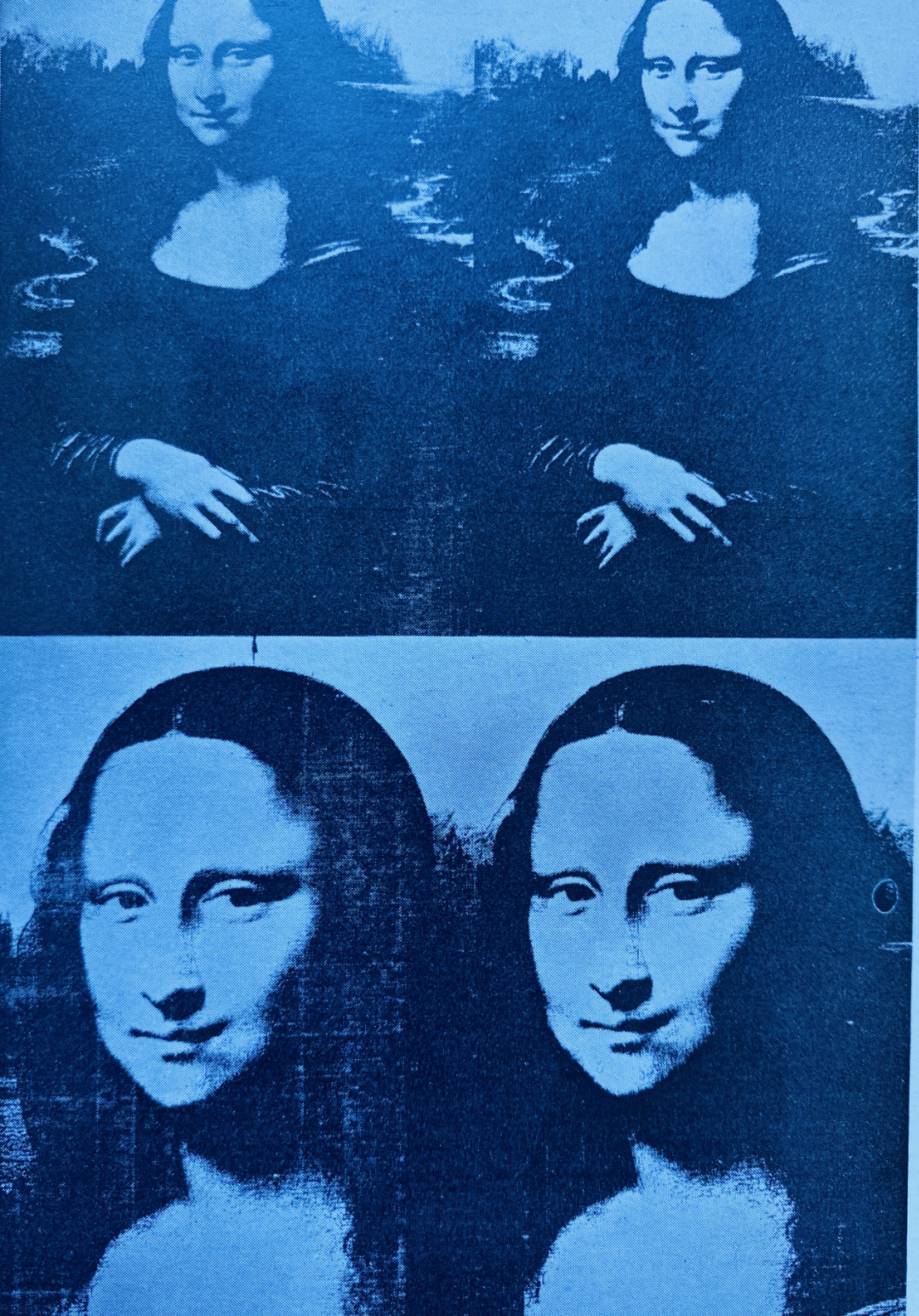
Andy Warhol, Mona Lisa, 1963, silkscreen print on canvas
DIGITAL/MATERIAL
New media contains an irresistible ephemeral tactility. A small image, confined behind glass that I can tap and stroke with my index finger. If displayed on a computer screen, I have to grip a small plastic pebble, which clicks as I press it. Or the track pad like an ice rink for my fingertip that washes and dances across its smooth ice.
The images are flexible, as I stretch and pinch them to zoom into their detail; their ugly artefaction emerges from the strange labyrinth. A horrible mosaic of pixels compared to the transcendent fogs of photographic grain or the frozen grease of dried paint. The qualities of the original medium now neutered into code. The translation of scanned photographic film, or the twice-removed echoes of photographed paintings, when juxtaposed next to each other in an online gallery, they all transform into the same sand. Electric data trapped beneath oxide-coated glass that I caress like a pet.
There’s a beautiful sense of release to digital media, as it simply evaporates when not being displayed on screen, like a genie that is summoned through these magic portals of phone, tablet, computer. We stick the tricorder back into our pocket and re-surface to reality and its static surround. Buildings, trees, furniture. Perhaps this is why there is so much pressure for re-development in city centres; a need to compete with the shifting sand of cyberspace. Everything seems like solid junk, ugly clutter compared to the fluid flexible and crucially optional noises of the infosphere.
More than ever life feels like a disassociate science fiction to me. Yesterday, wandering around Birmingham City Centre with a friend, we both remarked how alien it felt. Not just because of the oppressive physicality of the concrete jungle we drifted through, but also due the presence of people, each hustling around within their own narratives, the entire consumer infrastructure built around them to enable this. It’s normalised rituals increasingly bizarre. Shops. Cars. Food. Bars. Spaces. Images. Phones, the portals back to the Alternate.
It is as though real life is happening elsewhere. Namely online. As a society, as a culture, we seem to have migrated. The physical world now seems frustrating in its permanence, its intransigence, its laws of physics and biology. We awake from our somnambulant scrolling briefly to check our location. Oh. Back here again. What is this?
The objects I make are reflective of this disassociated experience. Permanent chunks of wreckage that I cling on to, to prove that I am real.
The belief that repeated proximity to an object will fulfill our senses, that a sense of identity and self-expression might be achieved through ownership of it. But such a transaction is now reduced to the banal process of consumerism, its promises proven to be lies. Why buy physical, when we know it leads nowhere, to only wanting more. Another reason to retreat to a world where content is free, although we overlook the fact we pay money to be connected to it.
And yet. The phenomenon of familiarity. Does it come as a relief after the seductions of online life, with its anonymous, instantaneous, disposable cheap thrills? A refuge we can curl up against. A commitment. Perhaps that’s why it’s so hard to sell. The knowledge that we (ourselves and the object) will grow old and tired, perhaps even quicker, in this fast forward hyperspace.
The physical properties become more apparent, more crucial. It’s only paint on paper, glued onto cardboard, surrounded by wood. What’s the big deal? Why should I invest not only my money in this debris, but my time, my own sense of permanence. It becomes a tattoo on the wall. (Perhaps a desire for permanence in sucha temporary world is a reason for the growth in tattoos?) Though ultimately this metaphor is untrue. Paintings and prints are not tattoos anymore than walls are skin and buildings bodies. Though they are baggage. Love affairs that evolve into marriage and then perhaps divorce. Or they become like an ex-partner that still hangs around like an embarrassment.
They stare back at me, reminding me of my own weakness and failure. Of why I’m better now. How we’ve both aged and changed! If I know I’m no longer the impressionable idealist I was when I found you at that craft market, then are you no longer the edgy street-cool statement you once were? I guess that’s the nature of reality. The ugly compromise that the glamour behind the glass of my device protects me from. My artworks seem just as alien as the non-digital reality they occupy. Patterns of pigment on paper that often refer to the phantoms on my phone.